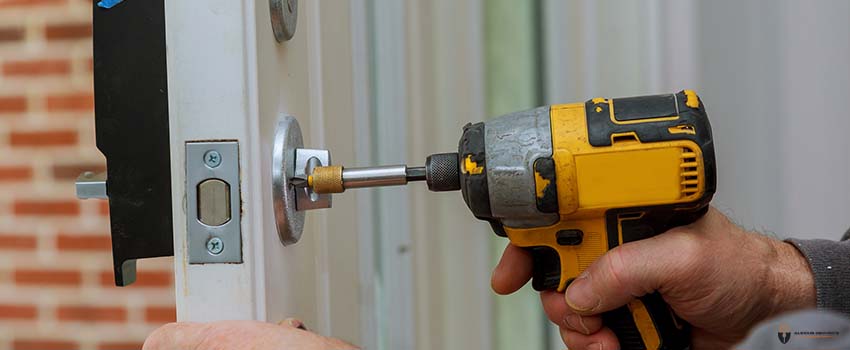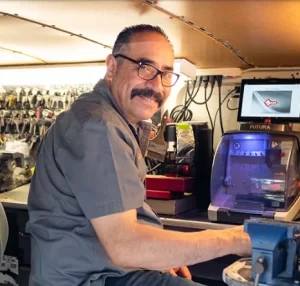The locks are the primary components that contribute to increased home security. While locks are often long-lasting, even the most sturdy lock can wear down with time and frequent use. However, regular lock maintenance can slow this wear and tear process. Lock maintenance improves security and augments durability, saving money on future lock repairs and replacements.
This article provides a comprehensive checklist highlighting the techniques used by professional locksmiths to maintain locks. Read on for handy lock maintenance tips to keep your home secure.
Maintenance of Door Locks
We use door locks every day yet frequently fail to maintain them. Most lock failures are caused by a lack of maintenance or faulty installation.
It’s typical to think that a door lock will always function properly, even without proper maintenance. However, most locksmiths agree that the typical lock has a seven-year lifetime. As with any mechanical object, dust and filth may get inside the door lock and stop it from working effectively. A sticky doorknob may happen due to the accumulation of dirt, rendering the door useless. Without regular maintenance, the lock will become exceedingly difficult to use, if not completely broken.
Maintaining locks isn’t on most people’s “to-do” lists, but it should be. Maintenance improves a lock’s performance and the length of time it operates, thereby saving you money as you won’t experience problems such as a sticky doorknob and won’t have to replace your locks as often.
1. Realigning the Lock
If your lock is not opening or locking smoothly, it is likely due to a misalignment of the latch bolt and striking plate. Lock misalignment is dangerous as it makes it harder to operate, reduces lifespan, lessens security, and increases wear and tear as force and pressure are required to operate it.
The easiest way of fixing a door lock that needs realigning is to elevate the striking plate and expand the strike hole in the door frame. Just be cautious not to put your new screw holes too close to the old ones; otherwise, the door may be easily kicked or pried open. Keep in mind that if your lock alignment changes once, it will change again in the future, which means it will become a regular element of your lock maintenance.
Maintenance Overview:
- Mark the location of the bolt or lock.
- As needed, adjust the strike plate.
- Drill fresh screw holes away from the old ones.
- Increase the size of the strike hole in the door frame.
2. Adjusting the Door
Your stuck door will produce the same issues as a misaligned lock. However, because the door catches on the frame, routinely maintaining your locks will not solve the problem. When adjusting a misaligned door, you will focus on the door rather than the lock. To fix it, you will concentrate on maintaining and repairing the door rather than the lock.
Extreme weather changes, particularly increases in humidity or precipitation, cause wood to expand. As a result, the deformed timber must be chopped and reshaped. These effects are more noticeable in solid wood and solid core doors than in hollow ones.
The first step in this type of door security maintenance is to open and close the door to see where it is catching. Once you’ve identified the troublesome area, use a pencil to mark it and determine how much material is in the way. Then you may remove the door and shave it down to the correct size.
When it comes to securing a sliding glass door, this form of lock maintenance will be the most challenging. Glass doors are difficult to remove, and the risk of shattering the glass when making modifications is always present. Before removing the door, lubricate the track.
Maintenance Overview:
- Make a note of where the door is catching on the frame.
- Take off the door.
- Remove any surplus wood from the door.
- Trim/shave the door
- Replace the trimmed door.
3. Fixing A Door Lock
In rare situations, dust and grime can clog the internal components of a door lock and prevent it from operating correctly. This may represent a build-up of dust and grime in the keyway, the bolt/latch apertures, or even deeper in the lock.
If you have a key trapped in the lock, the keyway may start to overflow. An overflowing keyway reduces the space available for the key to be inserted or retracted quickly. This situation can also occur if the bolt or actuator is obstructed. The area around these components must be free of obstructions.
Unless you’re dealing with heavier debris, cleaning your door lock boils down to using the correct lubrication. The most effective method will be to probe the debris and pull it out. If anything is stuck in the keyway, use the same techniques you’d use to extract a broken key from a lock.
Disassemble the lock for greater access when anything is wedged into a crevice beyond the point when lubricating, or other measures are ineffective. After disassembling the door locks, you may probe, pull, or lubricate the issue locations more efficiently.
Maintenance Overview:
- Apply a dry lubricant to the region that is clogged.
- To allow the lubrication to penetrate, turn the lock.
- If the debris does not come out, try probing and pulling.
- If everything else fails, remove the lock, disassemble it and clean it.
4. Lock Cleaning Solution
When most people think about maintenance, they typically think of rust removal. You can treat and prevent rust by maintaining your lock, but the optimum way will depend on how much rust you have.
You can spray an oil-based lubricant like WD-40 on a rusted surface to help remove a small amount of rust. Rub the rust away after applying the spray for locks to the affected areas. However, when spraying the inside of a lock, remember that oil-based lubrication might collect dirt and dust, potentially clogging the lock.
If you use a lot of oil, try disassembling the lock to clean and polish it to remove excess lube and prevent rust from returning. When lubrication is ineffective, immerse the hardware in a solution of water and vinegar with 5% acidity or employ electrolysis.
When protecting your property and baring entry, the most effective procedure is to install new locks rather than trying to maintain old ones. Cleaning locks with severe corrosion can be a complex procedure. In the case of substantial corrosion build-up, changing locks may be a better solution than trying to clean it.
Maintenance Overview:
- Wipe away liquified rust deposits with an oil-based lubricant.
- Remove the lubricant and polish the metal.
- Soak the lock in a vinegar solution for heavy-duty rust removal.
- Locks that are extremely rusted may need to be replaced.
5. Avoiding the Freeze
If you live in an area that experiences sub-zero conditions, you will also have experienced frozen locks. Here are some handy techniques that will show you how to prevent locks from freezing:
- Do not use hot water to unfreeze a lock unless you can wipe the water away after the lock unfreezes. Failure to remove excess water from the inside of the lock means it has the potential to freeze again and cause an even more significant blockage.
- Instead of using water to unfreeze a lock, use an isopropyl solution such as rubbing alcohol or hand sanitizer.
- Reducing the freezing by using an isopropyl alcohol-based solution is effective. Still, it also has a downside: the solution may collect dust and dirt and block the lock keyway.
- Also, remember that the more a lock freezes and thaws, the more likely corrosion will accumulate. Internal rust is difficult to remove, especially in locks like padlocks which cannot be disassembled and cleaned.
Maintenance Overview:
- Isopropyl alcohol should be applied to the frozen components.
- Oil the lock to avoid further ice formation.
- Oil can attract dirt, eventually clogging the lock.
- Rust can form as a result of repeated melting.
Conclusion
Frequently, starting lock maintenance after the lock is already degraded is like closing the stable door after the horse has bolted. By being proactive and maintaining the condition of your lock, you can ensure that it will continue to function for a more extended period.
If your lock is acting up, you might want to try cleaning it before replacing it. To clean the lock, use a solution like isopropyl alcohol which has anti-freeze properties, or an oil-based cleanser like WD40. If the lock is sticking a lot, it is best to pull it apart and completely clean it. However, if this is not possible, spray WD40 or any oil-based lubricant inside the locking mechanism.
Call In the Professionals Today!
Your locks are the starting point for physical protection and crime prevention. Locks are also a device you use daily and, as such, need regular maintenance. Improved lock maintenance will ensure that your locks function correctly and last longer. However, if you don’t know how to conduct lock maintenance, don’t know how to fix a sticky lock, or have too many demands on your time, you will need the services of a professional locksmith.
Contact Alexius Denver’s Locksmiths if you need a skilled locksmith to upgrade your security or maintain your locks. Our customers receive high-quality lock installation, repair, and maintenance services at the most reasonable prices. If you ever need a locksmith in Aurora CO, contact us and tell us about your problem and what you need, and we’ll be there in a jiffy to help you.






